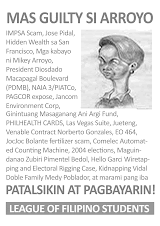BY MAURICE MALANES
Northern Dispatch
Human Rights Watch
Posted by Bulatlat
Vol. VII, No. 32, September 16-22, 2007
BAGUIO CITY (246 kms north of Manila) – Indigenous leaders and representatives have reason to be euphoric after the United Nations Declaration on the Rights of Indigenous Peoples was finally adopted on Sept. 13 before the UN concluded its 61st General Assembly.
"Sept. 13, 2007 will be remembered as...a day that the United Nations and its Member States, together with indigenous peoples, reconciled with past painful histories and decided to march into the future on the path of human rights," UN Permanent Forum on Indigenous Issues chairperson Victoria Tauli-Corpuz said in a statement from the UN headquarters in New York.
"This day will forever be etched in our memories as a significant gain in our peoples' long struggle for our rights as distinct peoples and cultures," she added.
Some 144 countries, including the Philippines, voted for the Declaration, which indigenous representatives have helped draft and have been pushing to be adopted for the past 23 years. Four countries (USA, Canada, Australia and New Zealand) voted against and 11 abstained.
"We are definitely happy (over the Declaration' s adoption), but it's a shame that four countries with significant indigenous populations have voted against it," Philippine Indigenous Peoples Human Rights Watch coordinator Joan Carling said.
The Declaration, although non-binding, sets out the individual and collective rights of indigenous peoples, including their rights to culture, identity, language, employment, health, education and other issues.
Carling hailed the Philippine government for voting for the Declaration, but stressed: "Let's hope government now reviews its policies favoring corporate interests and ensures that indigenous peoples participate in the management, control and development of their land and resources."
"This is a great advancement for Indigenous Peoples world wide," also said Lucy Mulenkei of the Kenya-based Indigenous Information Network, as she congratulated all the contributions of indigenous representatives worldwide.
The Declaration stresses the rights of indigenous peoples to maintain and strengthen their own institutions, cultures and traditions and to pursue their development in keeping with their own needs and aspirations. These were also referred as the right to self-determination.
It likewise prohibits discrimination against indigenous peoples and promotes their "full and effective participation" in all matters that concern them, and their right to remain distinct and pursue their own visions of economic and social development.
"The Ethnic Minority in Southeast Asia Programme (EM-SEAP) of FORUM-ASIA wishes to take part in this celebration and express our solidarity with all indigenous peoples," said Bernice See of the Bangkok-based FORUM-Asia. "We congratulate everyone who worked through the years, those who were in Geneva, New York and at home, and those who have sacrificed for the cause to bring about this minimum international standard for the promotion and protection of the rights of indigenous peoples."
Tauli-Corpuz said that the long time devoted to the Declaration was not wasted because it paved the way for "constructive dialog" among all stakeholders and led to "a better understanding of diverse world-views and cultures, a realignment of positions and, finally to the building of partnerships between states and indigenous peoples for a more and just and sustainable world."
While she respected the interpretive statements made by Member States, Tauli-Corpuz believed the significance and implications of the Declaration should not be minimized in any way, saying this would amount to discrimination.
"For us, the correct way to interpret the Declaration is to read it in its entirety or in a holistic manner and to relate it with existing international law," Tauli-Corpuz said.
For his part, Eugenio Insigne, the Philippine government representative to the UN, was quoted by a UN public information department's press release as saying that his delegation's support for the Declaration was "premised on the understanding that the right to self-determination shall not be construed as encouraging any action that would dismember or impair the territorial integrity or political unity of a sovereign or independent State."
The Human Rights Council adopted the Declaration in June 2006, over the objections of some Member States with sizable indigenous populations. The UN General Assembly deferred consideration of the text late last year at the behest of African countries, which raised objections about language on self-determination and the definition of "indigenous" people.
Insigne added that the government's support was also "based on the understanding that land ownership and natural resources were vested in the State."
The new Declaration is expected to serve as reference and framework by governments, UN agencies and the private sector in implementing what indigenous leaders call "a human rights-based approach to development" as it applies to indigenous peoples.
"I call on Governments, the UN system, indigenous peoples and civil society at large to rise to the historic task before us and make the UN Declaration on the Rights of Indigenous Peoples a living document for the common future of humanity," Tauli-Corpuz said. Northern Dispatch / Posted by Bulatlat

